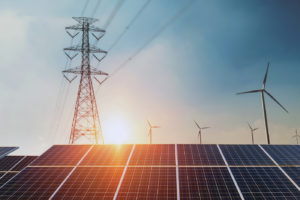10 Things Congress Can Do Right Now to Build Back Better For America, By America
Building back better is America’s path toward a clean, thriving, and equitable future. We need a recovery that addresses our nation’s persistent and unacceptably high levels of income inequality by creating millions of high-quality jobs in clean manufacturing, clean energy, restoration and resilience, the care economy, and upgrading our infrastructure and buildings. Importantly, these investments must be prioritized for communities that need it the most— especially low-income communities, communities of color, communities facing environmental injustice, and deindustrialized communities, in which workers face far higher rates of unemployment than national and state averages.
The time to act is now. The bipartisan infrastructure bill—called the Infrastructure Investment and Jobs Act (IIJA)—is the start, not the end, of what we need to build back better. Congress must act boldly and invest the full $3.5 trillion in the Senate Build Back Better budget resolution to build a clean, thriving, and equitable economy.
Voters do not want to wait. In six key states (MI, MN, OH, PA, WV, and WI), Democratic, Republican, and independent voters overwhelmingly (90%) said repairing and modernizing the nation’s physical infrastructure and rebuilding and retooling American manufacturing and modernizing our factories to build products and technology in the United States is very or fairly important to them. These voters also placed a high priority on strengthening America’s social infrastructure, public services, and human service workforce (84%). Increasing the production of clean energy and investing in innovative clean technologies was widely supported (72%).
To build back better we need a transformative pro-worker, pro-climate budget reconciliation package must include the following key priorities:

1. Ensure High-Road Labor and Domestic Content Standards: Economic recovery spending should translate into good paying jobs, support for domestic manufacturing, and benefits for disadvantaged. Efforts to build back better need to include prevailing wage and Buy America standards, as well as protections for organized labor—similar to the Protecting the Right to Organize (PRO Act)—to ensure working people have opportunities for high-quality jobs, such as restoring and enhancing tax deduction for union dues, reducing worker misclassification, and establishing civil penalties for unfair labor practices. It should also ensure at least 40% of the benefits of the investments go to disadvantaged communities.
2. Invest in Clean Energy Projects that Deliver Good Jobs: We need strong investment in the clean energy economy in order to reach net zero carbon emissions by 2050. These federal investments must support good, union jobs while also accomplishing our climate goals. Efforts to build back better need to provide robust funding for clean energy projects built with high-road labor standards and domestic content, specifically through clean energy and EV tax credits, in order to achieve our climate and economic recovery goals.
3. Boost Investments in Critical Water Infrastructure: The bipartisan bill didn’t provide nearly enough funding to replace every lead service line in the country and ensure clean water for all. We need to fix that by investing another $30 billion to get the job done in the budget. There are also critical funding gaps for clean and drinking water infrastructure, low-income water assistance, and other critical water infrastructure programs. Water infrastructure investments will boost our economy, address environmental injustice, create and sustain thousands of good jobs ensuring communities have clean, safe water and water systems resilient to climate change.

4. Upgrade our Schools & Buildings: Building back better must include investment in schools. We urge $130 billion over 10 years ($100 billion in grants and $30 billion in bonds) and $52 billion over 10 years for the testing and remediation of lead, PCBs—a dangerous chemical found in many schools—and other legacy toxins. These investments will help to address gaps in funding for repair and replacement of our crumbling school infrastructure. This is also our opportunity to make long-term investments in schools and other buildings which are the largest emitting sector, including Municipal Buildings, Universities, Schools, Hospitals (MUSH) buildings. While the bipartisan bill has some investments in building efficiency programs, it is not nearly enough to address the $1 trillion in deferred maintenance of these buildings or to capitalize on reducing emissions of energy-intensive buildings while making them safer and more resilient for students, teachers, support staff, nurses, and other occupants.
5. Support & Retool America’s Manufacturing Sector: Building back better means making a major investment in modernizing our energy-intensive industrial sector. It should include $6 billion over 10 years for widespread deployment of industrial efficiency and emissions reduction projects at energy-intensive industrial facilities nationwide, $15 billion to enable strategic energy intensive facilities to deploy technology that deeply cuts greenhouse gas and conventional pollution and safeguards critical industries and jobs in the U.S., and $100 million for a grant program to support small- and medium-sized manufacturers to develop environmental product declarations. Building back better requires significant funding for the 48C tax credit for targeted clean technology manufacturing and industrial emissions reduction, filling the $2-5 billion funding gap for the Advanced Technology Vehicle Manufacturing (ATVM) loan program, and addressing the greater than $25 billion in funding needed for manufacturing production and investment tax credits to fill clean technology supply chain gaps.
6. Ensure Fairness for Workers and Communities: America’s energy transition is well underway, but a transition that is fair for workers and communities isn’t something that will happen organically. Prioritizing and targeting federal resources to workers and communities in places impacted by this shift must be a deliberate choice. The reconciliation package needs to include a major investment in dislocated energy worker support, replacement of lost state/local revenue, and additional funding for programs that spur economic development and diversification in these regions. Finally, to build back better we need to extend the black lung excise tax for 10 years to maintain the funding that provides critical benefits to miners and families. These investments are crucial to support workers and communities who have borne and will continue to bear the brunt of job loss in this energy transition.

7. Rebuild the Public Sector and the Care Economy: Congress must include $650 billion for the care economy, with $400 billion for Medicaid Home and Community Based Services (HCBS). This funding would support workforce development, expand access to services, and equip those providing and receiving care in the community with tools necessary for crisis preparedness. These workers play an indispensable role in ensuring the health and safety of our communities. The public sector—including our frontline health care workers, home caregivers, social workers, teachers, and other public workers—play an indispensable role in ensuring the health and resilience of our communities.
8. Prioritize Community and Worker Resilience: Congress should expand funding for hazard mitigation and climate adaptation. This includes providing $7.7 billion over the next 5 years for FEMA’s Building Resilient Infrastructure and Communities (BRIC) program, and prioritizing a set-aside within BRIC for low-income, frontline, and BIPOC communities that often lack the capacity to apply for grant funding. Congress should also allocate $80 billion in funding for the Department of the Interior to support efforts to reduce drought conditions and wildfire risks, support local economies, create jobs, invest in resilience and restoration, and adequately address Tribal needs. Finally, an investment of $10 billion for a reinvigorated Civilian Climate Corps is needed to work on projects building climate resilience. This Corps should partner with unions, have labor representation, and have strong protections against private and public sector job displacement.
9. Invest in Transportation Systems: Safely and equitably transitioning the nearly 500,000 school buses on the road today to electric buses requires significant federal investment in deployment, as well as labor provisions for all workers impacted by the transition. At least $50 billion in federal investment in electric school bus deployment is needed to support a full-fleet transition, encompassing the price differential, workforce training, and charging infrastructure. Congress should also make additional investments in transit funding to meet transit needs and bolster the jobs and economic growth supported by transit. While transit funding received a significant investment in the bipartisan bill, more is needed to meet the current $176 billion backlog in transit needs. Building back better means connecting our communities, making sure all have access to transit, and creating good jobs in operations and transit manufacturing in the United States.

10. Support the Buildout of Energy Infrastructure: A federal investment of $40 billion over 10 years in the form of loan guarantees and tax credits to leverage additional private sector investment in transmission projects is needed to build back better. The bipartisan bill included only $2.5 billion for transmission build out, which is far below what is needed to build and upkeep new and existing lines. Congress should also revitalize the Smart Grid Investment Grant Program and increase funding for the Energy Storage program and Smart Grid Research and Development program in the DOE’s Office of Electricity Delivery. Finally, we should build on the success of the Energy Storage Technology Advancement Partnership and provide $50 million in funding over 10 years to DOE for competitive grants to communities for the installation of energy storage technologies—prioritizing disadvantaged or underserved communities and at critical facilities—such as hospitals and fire stations.
If we invest now at the scale needed to truly build back better, we can build a stronger, fairer, and cleaner economy that creates and sustains the high-quality jobs of the future and makes our communities and workers more resilient to crises.
The BlueGreen Alliance recently sent a letter to President Biden and leaders in Congress that discusses these 10 priorities in greater detail. You can read it here.